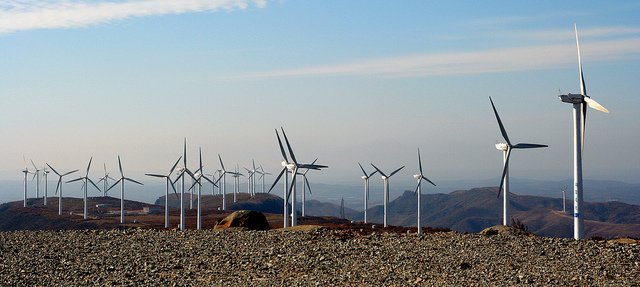Over the last years, China has become the world’s biggest market for renewables. But due to it’s ever growing energy demand, fossil fuels are still considered part of China’s energy future. YU Wenxuan sheds a light on the current state of China’s Energiewende.

China shows the highest growth rates of wind and solar capacity worldwide. Wind Farm in Heilongjiang Province. (Photo by Land Rover Our Planet, CC BY-ND 2.0)
By YU Wenxuan
The term “Energy Transition” in China means transforming the existing energy structure from relying on fossil fuels to effectively using all kinds of energies, especially clean, non-fossil energy sources to promote sustainable development of society and the economy. It aims to reduce the share of coal and oil in the country’s energy consumption and encourages renewable and clean energy.
Coal has dominated the energy consumption structure in China for a long time. According to BP, China was the world’s largest coal producer and consumer of energy overall in 2013. Under climate concerns, the most important approach is to restrict the use of coal in China.
Meanwhile, China’s net oil imports surpassed the U.S. as the world’s largest net oil importer in 2013. The country’s crude oil dependency is currently climbing towards 60%. While there are some who think that oil imports are helpful for maintaining energy security, others believe that large amounts of oil imports will also disrupt energy security.
For this reason, China, similar to Germany, is now more strongly emphasizing the use of clean, home-grown non-fossil energy. This trend is not new: Already in 2005, the Renewable Energy Law was promulgated (amended in 2009). The law’s goals were to “promote the development and utilization of renewable energy, increase the supply of energy, improve the infrastructure of energy, safeguard energy supply, protect the environment and push sustainable economic and social development. The 12th Five-Year Plan stresses the need for wind power development, photovoltaic power generation and shale gas exploration. It provides that there will be 6 large onshore and 2 coastal and offshore wind power bases (with an additional installed capacity of over 70 million kW) and solar energy power stations with a total installed capacity of over 5 million kW constructed during the five-year period by 2015.
In the past decade, the installed capacity of wind power developed rapidly in China. According to China’s 12th Five-Year Plan on Energy Development (2011-2015), wind generation capacity will reach 100 gigawatts, with an annual average increase of 26.4% compared with 2010 (31 gigawatts). In recent years, however, some provinces have limited wind power production because of the poor grid transmission capacity, causing great economic losses for the wind farms. In terms of photovoltaic power generation, China aims for 21 gigawatts by 2015, with an annual average increase of 89.5% compared with 2010 (0.86 gigawatts). Despite this ambitious plan, China’s photovoltaic industry – despite its size – is not strong enough. A fatal problem is a technological bottleneck. The role of China’s photovoltaic enterprises is just like a “factory” in the world’s photovoltaic industrial chain; but China lacks the technological advantages and advances. Germany’s strategies are very different and focus more on the issue of grid connection, instead of continuing to construct more wind farms and PV facilities without the necessary interconnection.
On the nuclear issue, China suspended the construction of nuclear power plants until 2012 after the Fukushima accident. In 2012 policy makers decided to restart nuclear power development in the coastal areas with stricter safety requirements. Evidently, China’s nuclear policy greatly differs from Germany’s nuclear phase-out. The leadership claims developing nuclear power helps to tackle climate change and the above-mentioned problems with wind and photovoltaic power. According to China’s 12th Five-Year Plan on Energy Development, the goal is to reach 40 gigawatts in 2015, with an annual average increase of 29.9% compared with 2010 (11 reactors, 10.82 gigawatts).
Natural gas is commonly regarded as a clean energy source in China, and the country started considering the exploitation of unconventional shale gas 10 years ago. China is generally successful in vertical well fracturing technology and has also verified some shale gas reserves. However, some difficulties and uncertainties remain, including unclear levels of reserves, poor ground construction conditions,technical obstacles, potential environmental risks and imperfect entrance and exit mechanisms.
In conclusion, China should focus on restricting the use of coal and the imports of oil for the sake of tackling climate change and safeguarding energy security while promoting the development of clean, non-fossil energy sources, such as wind power, photovoltaic power and shale gas to achieve energy transition in the long run. The German energy transition can shed light on this process, and Germany could engage in an important dialogue with China on this issue by sharing knowledge and experience.
Dr. YU Wenxuan is an associate professor and faculty advisor for master candidate at China University of Political Science and Law (CUPL), and director of Research and Development Division of Center for Legal Assistance to Pollution Victims (CLAPV). He specializes in energy law and environmental law and has published more than 60 academic papers related to environmental law and energy law since 2002. In June 2014 he published the monograph “Oil and Natural Gas Law in Background of Climate Change”.
Please note that you can find the key findings and a full translation of our book “German Energy Transition” in Mandarin here.
“In terms of photovoltaic power generation, China aims for 2,100 gigawatts by 2015”
Capacity in 2013 is ~18GW, and they are aiming to add 10-15GW per year. So this number sounds wrong by a few orders of magnitude.
Dear Greg, we have integrated the updated data provied by Yu Wenxuan. Thank you for catching the mistake. Best, Alexander
The solar figure is outdated. The Chinese national energy administration had adjusted target for 2015 to 35GW a while ago.